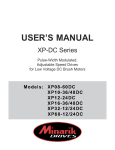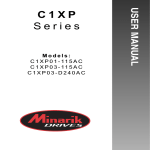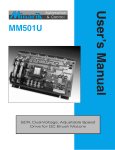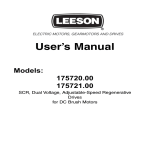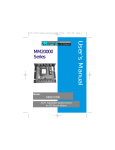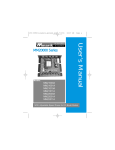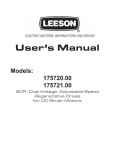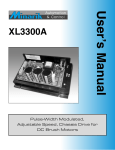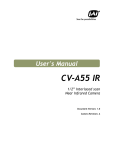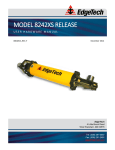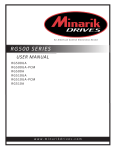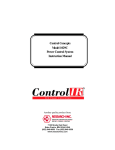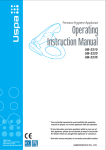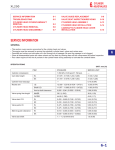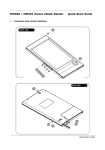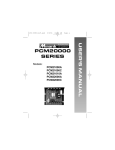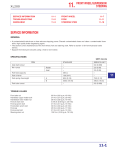Download User Manual - Galco Industrial Electronics
Transcript
MODELS: MM311U MM301U MM301A User ’s Manual MM300 Series Isolated Input, Dual Voltage, Variable Speed SCR Drives for Brush Motors Copyright © 2013 by Minarik Drives All rights reserved. No part of this manual may be reproduced or transmitted in any form without written permission from Minarik Drives. The information and technical data in this manual are subject to change without notice. Minarik Drives and its Divisions make no warranty of any kind with respect to this material, including, but not limited to, the implied warranties of its merchantability and fitness for a given purpose. Minarik Drives and its Divisions assume no responsibility for any errors that may appear in this manual and make no commitment to update or to keep current the information in this manual. Printed in the United States of America. I Safety Warnings This symbol denotes an important safety tip or warning. Please read these sec- tions carefully prior to performing any of the instructions contained in that section. • Have a qualified electrical maintenance technician install, adjust and service this equipment. Follow the National Electrical Code and all other applicable electrical and safety codes, including the provisions of the Occupational Safety and Health Act (OSHA), when installing equipment. • Reduce the chance of an electrical fire, shock, or explosion by proper grounding, over-current protection, thermal protection, and enclosure. Follow sound maintenance procedures. • It is possible for a drive to run at full speed as a result of a component failure. Please ensure that a master switch has been placed in the AC line to stop the drive in an emergency. • This drive is isolated from earth ground. Circuit potentials are at 115 VAC or 230 VAC above earth ground. Avoid direct contact with the printed circuit board or with circuit elements to prevent the risk of serious injury or fatality. Use a non-metallic screwdriver for adjusting the calibration trimpots. II Contents Safety Warnings . . . . . . . . . . . . . . . . . . . . . . . . . . . . . . . . . . . . . . . . . . . . . . . . . . . . . . .i Specifications . . . . . . . . . . . . . . . . . . . . . . . . . . . . . . . . . . . . . . . . . . . . . . . . . . . . . . . . .1 Dimensions . . . . . . . . . . . . . . . . . . . . . . . . . . . . . . . . . . . . . . . . . . . . . . . . . . . . . . . . . .3 Installation . . . . . . . . . . . . . . . . . . . . . . . . . . . . . . . . . . . . . . . . . . . . . . . . . . . . . . . . . . .6 Wiring . . . . . . . . . . . . . . . . . . . . . . . . . . . . . . . . . . . . . . . . . . . . . . . . . . . . . . . . . . . . .6 Shielding Guidelines . . . . . . . . . . . . . . . . . . . . . . . . . . . . . . . . . . . . . . . . . . . . . . . . . .7 Chassis Drives (MM301U, MM311U) . . . . . . . . . . . . . . . . . . . . . . . . . . . . . . . . . . . .8 Mounting . . . . . . . . . . . . . . . . . . . . . . . . . . . . . . . . . . . . . . . . . . . . . . . . . . . . . . . . .8 Heatsinking . . . . . . . . . . . . . . . . . . . . . . . . . . . . . . . . . . . . . . . . . . . . . . . . . . . . . . .9 Line Fusing . . . . . . . . . . . . . . . . . . . . . . . . . . . . . . . . . . . . . . . . . . . . . . . . . . . . . . .9 Speed adjust potentiometer . . . . . . . . . . . . . . . . . . . . . . . . . . . . . . . . . . . . . . . . .10 Cage-clamp terminals . . . . . . . . . . . . . . . . . . . . . . . . . . . . . . . . . . . . . . . . . . . . . .11 Connections . . . . . . . . . . . . . . . . . . . . . . . . . . . . . . . . . . . . . . . . . . . . . . . . . . . . .12 Motor . . . . . . . . . . . . . . . . . . . . . . . . . . . . . . . . . . . . . . . . . . . . . . . . . . . . . . . . .12 Power Input . . . . . . . . . . . . . . . . . . . . . . . . . . . . . . . . . . . . . . . . . . . . . . . . . . .14 Field Output . . . . . . . . . . . . . . . . . . . . . . . . . . . . . . . . . . . . . . . . . . . . . . . . . . .14 START/STOP pushbuttons . . . . . . . . . . . . . . . . . . . . . . . . . . . . . . . . . . . . . . . .15 Tachometer feedback . . . . . . . . . . . . . . . . . . . . . . . . . . . . . . . . . . . . . . . . . . . .15 Voltage or current follower . . . . . . . . . . . . . . . . . . . . . . . . . . . . . . . . . . . . . . . .16 Slide switches . . . . . . . . . . . . . . . . . . . . . . . . . . . . . . . . . . . . . . . . . . . . . . . . .17 Enclosed Drives (MM301A) . . . . . . . . . . . . . . . . . . . . . . . . . . . . . . . . . . . . . . . . . .19 Mounting . . . . . . . . . . . . . . . . . . . . . . . . . . . . . . . . . . . . . . . . . . . . . . . . . . . . . . . .19 Heatsinking . . . . . . . . . . . . . . . . . . . . . . . . . . . . . . . . . . . . . . . . . . . . . . . . . . . . . .20 Line Fusing . . . . . . . . . . . . . . . . . . . . . . . . . . . . . . . . . . . . . . . . . . . . . . . . . . . . . .20 Connections . . . . . . . . . . . . . . . . . . . . . . . . . . . . . . . . . . . . . . . . . . . . . . . . . . . . .21 Motor . . . . . . . . . . . . . . . . . . . . . . . . . . . . . . . . . . . . . . . . . . . . . . . . . . . . . . . . .22 III Operation . . . . . . . . . . . . . . . . . . . . . . . . . . . . . . . . . . . . . . . . . . . . . . . . . . . . . . . . . . .24 Before applying power (all models) . . . . . . . . . . . . . . . . . . . . . . . . . . . . . . . . . . . . .24 Chassis Drives (MM301U, MM311U) . . . . . . . . . . . . . . . . . . . . . . . . . . . . . . . . . . . .24 Speed adjust potentiometer input with START/STOP pushbuttons . . . . . . . . . . . .25 Diagnostic LEDs . . . . . . . . . . . . . . . . . . . . . . . . . . . . . . . . . . . . . . . . . . . . . . . . . . .26 Line starting and line stopping . . . . . . . . . . . . . . . . . . . . . . . . . . . . . . . . . . . . . . . .27 Decelerating to minimum speed . . . . . . . . . . . . . . . . . . . . . . . . . . . . . . . . . . . . . . .27 Dynamic braking . . . . . . . . . . . . . . . . . . . . . . . . . . . . . . . . . . . . . . . . . . . . . . . . . . .28 Dynamic brake resistor value . . . . . . . . . . . . . . . . . . . . . . . . . . . . . . . . . . . . . . . . .28 Enclosed Drive Operating Modes (Manual / Auto) . . . . . . . . . . . . . . . . . . . . . . . . .30 Enclosed Drive Operation . . . . . . . . . . . . . . . . . . . . . . . . . . . . . . . . . . . . . . . . . . . .31 Calibration . . . . . . . . . . . . . . . . . . . . . . . . . . . . . . . . . . . . . . . . . . . . . . . . . . . . . . . . . .32 Drive Calibration Procedure . . . . . . . . . . . . . . . . . . . . . . . . . . . . . . . . . . . . . . . . . .34 MINIMUM SPEED (MIN SPD) . . . . . . . . . . . . . . . . . . . . . . . . . . . . . . . . . . . . . . . . .35 MAXIMUM SPEED (MAX SPD) . . . . . . . . . . . . . . . . . . . . . . . . . . . . . . . . . . . . . . . .35 CURRENT LIMIT . . . . . . . . . . . . . . . . . . . . . . . . . . . . . . . . . . . . . . . . . . . . . . . . . . .36 IR COMPENSATION (IR COMP) . . . . . . . . . . . . . . . . . . . . . . . . . . . . . . . . . . . . . .37 ACCELERATION (ACCEL) . . . . . . . . . . . . . . . . . . . . . . . . . . . . . . . . . . . . . . . . . . .39 DECELERATION (DECEL) . . . . . . . . . . . . . . . . . . . . . . . . . . . . . . . . . . . . . . . . . . .39 TACH VOLTS . . . . . . . . . . . . . . . . . . . . . . . . . . . . . . . . . . . . . . . . . . . . . . . . . . . . .40 Application Notes . . . . . . . . . . . . . . . . . . . . . . . . . . . . . . . . . . . . . . . . . . . . . . . . . . . .42 Multiple fixed speeds . . . . . . . . . . . . . . . . . . . . . . . . . . . . . . . . . . . . . . . . . . . . . . . .42 Adjustable speeds using potentiometers in series . . . . . . . . . . . . . . . . . . . . . . . . .43 Independent adjustable speeds Reversing . . . . . . . . . . . . . . . . . . . . . . . . . . . . . . . . . . . . . . .44 . . . . . . . . . . . . . . . . . . . . . . . . . . . . . . . . . . . . . . . . . . . . . . . . . . . . . . . .45 RUN/JOG switch . . . . . . . . . . . . . . . . . . . . . . . . . . . . . . . . . . . . . . . . . . . . . . . . . . .46 Reversing with a DIGI=LOK Controller, Model DLC600 . . . . . . . . . . . . . . . . . . . . .47 IV Troubleshooting . . . . . . . . . . . . . . . . . . . . . . . . . . . . . . . . . . . . . . . . . . . . . . . . . . . . . .48 Unconditional Warranty . . . . . . . . . . . . . . . . . . . . . . . . . . . . . . . . . . . . . . . . . . . . . . .54 V Illustrations Fig. Description 1. MM301U and MM311U Dimensions . . . . . . . . . . . . . . . . . . . . . . . . . . . . . . . . . .3 Page 2. MM301A Dimensions . . . . . . . . . . . . . . . . . . . . . . . . . . . . . . . . . . . . . . . . . . . . . 4 3. MM300 Series Layout . . . . . . . . . . . . . . . . . . . . . . . . . . . . . . . . . . . . . . . . . . . . .5 4. Speed Adjust Potentiometer . . . . . . . . . . . . . . . . . . . . . . . . . . . . . . . . . . . . . . . .10 5. Cage-Clamp Terminal . . . . . . . . . . . . . . . . . . . . . . . . . . . . . . . . . . . . . . . . . . . . .11 6. MM301U and MM311U AC Line, Motor and Field Connections . . . . . . . . . . . . .13 7. Signal Follower Connection . . . . . . . . . . . . . . . . . . . . . . . . . . . . . . . . . . . . . . . .16 8. Slide Switches . . . . . . . . . . . . . . . . . . . . . . . . . . . . . . . . . . . . . . . . . . . . . . . . . .18 9. MM301A Connections . . . . . . . . . . . . . . . . . . . . . . . . . . . . . . . . . . . . . . . . . . . .23 10. Current Limit and Power LEDs . . . . . . . . . . . . . . . . . . . . . . . . . . . . . . . . . . . . . .26 11. Run/Decelerate to Minimum Speed Switch . . . . . . . . . . . . . . . . . . . . . . . . . . . . .28 12. Dynamic Brake Connection . . . . . . . . . . . . . . . . . . . . . . . . . . . . . . . . . . . . . . . .29 13. Calibration Trimpot Layout . . . . . . . . . . . . . . . . . . . . . . . . . . . . . . . . . . . . . . . . .33 14. Typical CURRENT LIMIT, and IR COMP Settings for MM300 Series (actual settings may vary wtih each application) . . . . . . . . . . . . . . . . . . . . . . . .38 15. Mutiple Fixed Speeds . . . . . . . . . . . . . . . . . . . . . . . . . . . . . . . . . . . . . . . . . . . . .42 16. Adjustable Fixed Speeds Using Potentiometers in Series . . . . . . . . . . . . . . . . .43 17. Independent Adjustable Speeds 18. Reversing Circuit Connection . . . . . . . . . . . . . . . . . . . . . . . . . . . . . . . . . . . . . . .45 19. RUN/JOG Switch Connection to Speed Adjust Potentiometer . . . . . . . . . . . . . .46 20. Reversing with a DLC600 . . . . . . . . . . . . . . . . . . . . . . . . . . . . . . . . . . . . . . . . . .47 21. MM300 Series Block Diagram . . . . . . . . . . . . . . . . . . . . . . . . . . . . . . . . . . . . . .52 . . . . . . . . . . . . . . . . . . . . . . . . . . . . . . . . . . . .44 VI Tables Fig. Description 1. Recommended Line Fuse Sizes . . . . . . . . . . . . . . . . . . . . . . . . . . . . . . . . . . . . .9 Page 2. Field Output Connections for Chassis Drives . . . . . . . . . . . . . . . . . . . . . . . . . . .14 3. Replacement Parts . . . . . . . . . . . . . . . . . . . . . . . . . . . . . . . . . . . . . . . . . . . . . . .53 1 Specifications Model Max. Armature Current (Amps DC) HP Range with 115 VAC Applied HP Range with 230 VAC Applied MM311U 3.0 1/20–1/8 1/10–1/4 MM301U 10.0 1/4–1 1/2–2 MM301A 10.0 1/4–1 1/2–2 AC Line Voltage 115 VAC or 230 V AC, 50 or 60 Hz, 1 Phase Armature Voltage (115 VAC Input) 0–90 VDC Armature Voltage (230 VAC Input) 0–180 VDC Form Factor 1.37 at base speed Field Voltage (115 VAC) 50 VDC (F1 to L1); 100 VDC (F1 to F2) Field Voltage (230 VAC) 100 VDC (F1 to L1); 200 VDC (F1 to F2) Maximum Field Current 1 ADC Acceleration Time Range (with no load) 1-11 seconds Deceleration Time Range (with no load) 1-11 seconds Analog Input Voltage Range (S1 to S2) Input Impedance (S1 to S2) 0-10 VDC or 4-20 mADC >100K ohms Load Regulation (% of base speed) with Armature Feedback with Tachogenerator Feedback Vibration 1% or better 0.1% 0.5G max. (0-50 Hz); 0.1G max. (>50 Hz) Specifications 2 Ambient Temperature Range Open Chassis 10°C-55°C Cased 10°C-45°C Weight Open Chassis 2.1 lbs (953 grams) Cased 7.75 lbs (3.5 kilograms) Tachogenerator Feedback Voltage Range 7-50 VDC per 1000RPM Short-circuit current rating (SCCR) is the maximum short-circuit current that the speed control can safely withstand when protected by a specific over-current protective device(s). The rating for models rated more than 1 HP is tabulated below: Drive Short Circuit Model No. Current Rating Types of Branch Circuit Protection Maximum Rating of Overcurrent Protection Maximum Maximum Current, Voltage, kA V MM301U 10,000 240V Non-time Inverse Delay K5 Time Circuit Fuse Breaker 30A MM301A 10,000 240V Non-time Inverse Delay K5 Time Fuse Circuit Breaker 30A 3 Dimensions 0.19 [5] 4.46 [113] 3.00 [76] 0.70 [18] 0.60 [15] 0.77 [19] 1.90 [48] 0.98 [25] 6.30 [160] 6.90 [175] SIX (6) MOUNTING SLOTS 0.18 [5] WIDE x 0.30 [8] DEEP ALL DIMENSIONS IN INCHES [MILLIMETERS] Figure 1. MM301U and MM311U Dimensions 4 Dimensions 6.90 [175] 6.30 [160] 1.40 [36] 10.22 [260] 9.80 [249] 7.00 [178] 0.22 [6] 1.45 [37] 5.51 [140] 4.78 [121] 2.31 [59] 0.12 [3] 1.50 [38] 1.50 [38] THREE 0.88 [22] KNOCKOUTS ALL DIMENSIONS IN INCHES [MILLIMETERS] Figure 2. MM301A Dimensions Layout 5 ACCEL AND DECEL TRIMMER POTENTIOMETERS (P503, P504) IR COMP TRIMMER POTENTIOMETER (P506) FEEDBACK SELECTOR SWITCH (SW505) CURRENT LIMIT TRIMMER POTENTIOMETER (P505) POWER LED (IL502) TACHOGENERATOR VOLTAGE TRIMMER POTENTIOMETER (P507) CURRENT LIMIT LED (IL501) TACHOGENERATOR TERMINAL BLOCKS SPEED ADJUST POTENTIOMETER TERMINAL BLOCKS START/STOP TERMINAL BLOCKS LINE VOLTAGE SELECTOR SWITCHES (SW501, SW502) 10-TURN MAXIMUM AND MINIMUM SPEED TRIMMER POTENTIOMETERS (P501, P502) CURRENT/VOLTAGE SIGNAL SELECTOR SWITCH (SW504) AC LINE FUSES (FU501-FU502) AC LINE VOLTAGE TERMINAL BLOCKS ARMATURE TERMINAL BLOCKS ARMATURE VOLTAGE SELECTOR SWITCH (SW503) FIELD TERMINAL BLOCKS Figure 3. MM300 Series Layout 6 Installation Wiring Use 12 AWG wire for the AC line voltage (L1 and L2), motor armature (A1 and A2), and dynamic brake resistor (if used). Use 18 AWG wire for logic (field output, speed adjust potentiometer, tachogenerator, etc.) Twist logic wires to avoid picking up unwanted electrical noise. Use shielded cable if wires are longer than 12 inches (30 cm). Do not bundle logic wires with power carrying wires. This can cause erratic operation. Keep logic wires in a conduit separated by at least 2 inches from power carrying wires. Do not allow logic wires to travel in parallel to power carrying wires for more than 1 inch. It may be necessary to earth ground the shielded cable. If noise is produced by devices other than the drive, ground the shield at the drive end. If noise is generated by a device on the drive, ground the shield at the end away from the drive. Do not ground both ends of the shield. Installation 7 Shielding guidelines Warning Under no circumstances should power and logic leads be bundled together. Induced voltage can cause unpredictable behavior in any electronic device, including motor controls. As a general rule, Minarik recommends shielding of all conductors. If it is not practical to shield power conductors, Minarik recommends shielding all logic-level leads. If shielding logic level leads is not practical, the user should twist all logic leads with themselves to minimize induced noise. It may be necessary to earth ground the shielded cable. If noise is produced by devices other than the drive, ground the shield at the drive end. If noise is generated by a device on the drive, ground the shield at the end away from the drive. Do not ground both ends of the shield. If the drive continues to pick up noise after grounding the shield, it may be necessary to add AC line filtering devices, or to mount the drive in a less noisy environment. Logic wires from other input devices, such as motion controllers and PLL velocity controllers, must be separated from power lines in the same manner as the logic I/O on this drive. 8 Installation Chassis Drives (MM301U, MM311U) Mounting Mount the drive with its board in either a horizontal or vertical plane. Four 0.188 inch (4.8 mm) wide slots in the chassis accept #8 pan head screws. The chassis units do not have to be earth grounded. If you choose to ground the chassis, use a star washer beneath the head of at least one of the mounting screws to penetrate the anodized chassis surface and to reach bare metal. Drive components are sensitive to electrostatic fields. Avoid contact with the circuit board directly. Hold the drive by the chassis only. Protect the drive from dirt, moisture, and accidental contact. Provide sufficient room for access to the terminal block and calibration trimpots. Mount the drive away from other heat sources. Operate the drive within the specified ambient operating temperature range. Prevent loose connections by avoiding excessive vibration of the drive. Observe the following guidelines when installing an isolation transformer: • A power disconnecting device must be installed between the power line and primary of the transformer. • If the power disconnecting device is a circuit breaker, the circuit breaker trip rating must be coordinated with the in-rush current (10-12 times full load current) of the transformer. Installation 9 Heatsinking The MM301U and MM311U contain sufficient heat sinking in its original configuration. No additional heat sinking is necessary when installed in accordance with the guidelines specified in this instruction manual. The chassis plate acts as the thermal heatsink. Line fusing MM300 Series drives have line fuses mounted on fuse holders 501 and 502 (FU501 and FU502). See the Replacement Parts section for preinstalled line fuse size. When replacing the line fuses, use fast acting fuses rated for 250 VAC or higher, and at least 200% of the armature current. See Figure 3 (page 5) for fuse holder location, and Table 1 for recommended line fuse sizes. Table 1. Recommended Line Fuse Sizes 90 VDC Motor Horsepower 180 VDC Motor Horsepower Max. DC Armature Current (amps) AC Line Fuse Size (amps) 1/20 1/10 0.5 1/15 1/8 0.8 3 3 1/8 1/4 1.5 5 1/6 1/3 1.7 5 1/4 1/2 2.6 8 1/3 3/4 3.5 8 1/2 1 5.0 10 7.6 15 3/4 1 1/2 Minarik Drives offers a 63 mA pico fuse (part number 050-0081) which protects the transformer and logic. 10 Installation Speed adjust potentiometer Install the circular insulating disk between the mounting panel and the 10K ohm speed adjust potentiometer (see Figure 4). Mount the speed adjust potentiometer through a 0.38 inch (10 mm) hole with the hardware provided. Twist the speed adjust potentiometer wire to avoid picking up unwanted electrical noise. If potentiometer leads are longer than 18 inches (46 cm), use shielded cable. Alternate speed adjust potentiometer connections may be found in the Application Notes section of this user guide. Note: The user may choose to install a 5K ohm speed adjust potentiometer; however, the MIN SPD and MAX SPD trimpots must be recalibrated if the 5K ohm potentiometer is used. Figure 4. Speed Adjust Potentiometer Installation 11 Cage-clamp terminals Logic connections are made to a cage-clamp terminals. To insert a wire into the cageclamp terminal: 1. Press down on the lever arm using a small screwdriver. 2. Insert wire into the wire clamp 3. Release the lever arm to clamp wire. Figure 5. Cage-Clamp Terminal 12 Installation Connections Motor Warning Under no circumstances should power and logic leads be bundled together. Induced voltage can cause unpredictable behavior in any electronic device, including motor controls. Connect a motor to terminals A1 and A2 as shown in Figure 6 (page 13). Ensure that the motor voltage rating is consistent with the drive’s output voltage. Minarik drives supply motor voltage from A1 and A2 terminals (TB501). It is assumed throughout this manual that when A1 is positive with respect to A2, the motor will rotate clockwise (CW) while looking at the output shaft protruding from the front of the motor. If this is opposite of the desired rotation, simply reverse the wiring of A1 and A2 with each other. Installation NOTE: DO NOT make any connections to F1 and F2 if using a permanent magnet motor. SPEED ADJUST POTENTIOMETER 10K OHMS N.O. Start N.C. Stop NOTE: IF PUSHBUTTONS ARE NOT USED, CONNECT B1 TO B3. 115 VAC 230 VAC POWER SWITCH AC LINE VOLTAGE FIELD OUTPUT SHUNT-WOUND MOTORS ONLY SEE NOTE 4 TACHOGENERATOR (OPTIONAL) NOTES 1. L1 IS THE HOT TERMINAL. 2. L2/115 IS THE NEUTRAL TERMINAL FOR 115 VAC INPUT. 3. TYPICAL FIELD CONNECTIONS SHOWN. REFER TO TABLE 2 (PAGE 14) FOR ALTERNATE FIELD CONNECTIONS. Figure 6. MM301U and MM311U AC Line, Motor and Field Connections 13 Installation 14 Power Input Connect the AC line power leads to terminals L1 and L2 and install a master power switch in the voltage input line as shown in Figure 6 (page 13). The switch contacts should be rated at a minimum of 250 volts and 200% of maximum drive current. Field output The field output is for shunt wound motors only. Do not make any connections to F1 and F2 (TB501) when using a permanent magnet motor. See Table 2 for field output connections. Table 2. Field Output Connections for Chassis Drives Line Voltage Approximate Connect Motor (VAC) Field Voltage (VDC) Field To 115 50 F1 and L1 115 100 F1 and F2 230 100 F1 and L1 230 200 F1 and F2 Installation 15 START/STOP pushbuttons Pushbutton operation of the MM300 Series requires a momentary normally open STOP pushbutton be wired to terminals B2 and B3 and a momentary normally closed START pushbutton wired to terminals B1 and B2. These switches must be used together and are not included with the drive. The B1, B2 and B3 terminals are on terminal block TB502. If the START/STOP pushbuttons are not used, wire a jumper between terminals B1 and B3 to bypass the latching circuit. The drive will then operate in a power-up start mode. See Figure 6 (page 13) for these switch connections. Tachometer feedback Using tachometer feedback improves speed regulation from approximately 1% of motor base speed to approximately 0.1% of motor base speed. Use tachometers rated from 7 VDC per 1000 RPM to 50 VDC per 1000 RPM. Connect the tachometer to terminals T1 and T2 of terminal block 502 (TB502). Place SW504 in the TACH position. See Figure 6 (page 13) for tachometer connections. The TACH trimpot trimpot must be adjusted prior to operating with tachometer feedback. Refer to the Calibration section for instructions on calibrating the TACH trimpot. 16 Installation Voltage or current follower Instead of using a speed adjust potentiometer, MM300 Series drives may be wired to follow an analog input signal (see Figure 6 for connections). This input signal can be in the form of voltage (0-10 VDC) or current (4-20 mA). Because these drives have built in isolation the input signal can be either grounded or ungrounded. The signal slide switch must also be set for current or voltage input (see Slide switches section). Figure 7. Signal Follower Connection Installation 17 Slide switches Warning Change slide switch settings only when the drive is disconnected from the AC line voltage. Make sure both line voltage and motor switches are set to their correct position. If the switches are improperly set to a lower voltage position, the motor will not run at full voltage and may cause transformer damage. If the switches are improperly set to a higher voltage position, the motor will over speed, which may cause motor damage. LINE VOLTAGE (SW501 and SW502) Select the appropriate line voltage: 115 for 115 VAC line voltage, or 230 for 230 VAC line voltage. MOTOR (SW503) Select the maximum armature voltage: 90V for 90 VDC motors, or 180V for 180 VDC motors. SIGNAL (SW504) Select the input signal being used: CURR for current input signal, or VOLT for voltage input signal or speed adjust potentiometer input. 18 Installation FEEDBACK (SW505) Select the appropriate feedback option: ARMATURE for armature feedback, or TACH for tachometer feedback. See Figure 8 for all slide switch locations. VOLTAGE SELECT SWITCHES (SW501,SW502) FEEDBACK SELECT SWITCH (SW505) 18 ARMATURE A VOLTAGE SELECT (SW503) G SIGNAL SOURCE SELECT (SW504) Figure 8. Slide Switches Installation 19 Enclosed drive Mounting The NEMA 4X enclosed drive comes with 0.88 inch (22mm) conduit knockout holes at the bottom of the enclosure. The units may be vertically wall mounted using the four 0.19 inch (5 mm) slotted holes on the attached heat sink. For motor loads less than 5 ADC, the drive may be bench mounted horizontally, or operated without mounting. Mount the drive as follows: 1. Install the mounting screws. 2. For access to the terminal strip, turn the slotted screw on the front cover counterclockwise until it is free from the enclosure. The right side of the cover is hinged to the enclosure. Pull the slotted screw to open the enclosure. 3. Carefully remove the conduit knockouts by tapping them into the enclosure and twisting them off with pliers. 4. Install conduit hardware through the 0.88 inch (22 mm) knockout holes. Connect external wiring to the terminal block. 5. Grasp the slotted screw and tilt the front cover back into place. Avoid pinching any wires between the front cover and the enclosure. 6. Turn the slotted screw clockwise until tight to secure the front cover. 7. Set the POWER switch to the OFF position before applying AC line voltage. 20 Installation Heat sinking The enclosed MM300 Series drive contains sufficient heat sinking in its basic configuration. No additional heat sinking is necessary when installed in accordance with the guidelines specified in this manual. Line fusing WARNING: Most code requires that upstream branch protection be provided to protect input power wiring. Failure to observe this precaution could result in severe bodily injury or loss of life. This MM300U Series has 15-amp line fuses preinstalled on fuse holders 501 and 502 (FU501 and FU502). When replacing the line fuses, use fast acting fuses rated for 250 VAC or higher. See Figure 3 (page 5) for fuse holder location and Table 1 (page 9) for recommended line fuse sizes. Installation Connections WARNING: A single fault like a power device short may cause motor rotation when in the stop mode. The user is responsible for assuring safe conditions for operating personal by providing suitable guards, audio or visual alarms, or other devices. Failure to observe these precautions could result in bodily injury. WARNING: To provide the motor with overload protection, local, national, and international codes (e.g.,NEC/CEC) require that a motor thermostat, internal to the motor, be installed or an electronic thermal motor overload relay, sized to protect the motor, installed between the motor and the drives’ output terminals. WARNING: Do not connect this equipment with power applied. Failure to observe this precaution may result in fire or serious injury. 21 22 Installation Connections Motor Warning Under no circumstances should power and logic leads be bundled together. Induced voltage can cause unpredictable behavior in any electronic device, including motor controls. Connect a motor to terminals A1 and A2 as shown in Figure 9 (page 23). Ensure that the motor voltage rating is consistent with the drive’s output voltage. Minarik Drives motor speed controls supply motor voltage from A1 and A2 terminals. It is assumed throughout this manual that when A1 is positive with respect to A2, the motor will rotate clockwise (CW) while looking at the output shaft protruding from the front of the motor. If this is opposite of the desired rotation, simply reverse the wiring of A1 and A2 with each other. 8 9 RE F 7 23 COM 6 A2 5 A1 4 F1 3 L2 (115) 2 L2 (230) L1 1 F2 Installation COM (–) REF (+) – 230 VAC MOTOR ARMATURE SEE NOTES 1, 2, AND 3 + 115 VAC EARTH GROUND (GREEN SCREW) 115/230 VAC LINE VOLTAGE INPUT FIELD COIL SEE NOTE 4 1. 2. 3. 4. 5. 0 – 10 VDC OR 4 – 20 mADC INPUT SIGNAL L1 IS THE HOT TERMINAL. L2/115 IS THE NEUTRAL TERMINAL FOR 115 VAC INPUT. L2/230 IS THE NEUTRAL TERMINAL FOR 230 VAC INPUT. TYPICAL FIELD CONNECTIONS SHOWN. REFER TO TABLE 2 (PAGE 14) REMOVE THE 510 OHM INTERNAL RESISTOR CONNECTED BETWEEN TERMINALS 8 & 9 IF YOU ARE USING A 0-10V REMOTE INPUT SIGNAL Figure 9. MM301A AC Line, Motor and Field Connections 24 Operation Before applying power 1. Set LINE VOLTAGE SELECT switches SW501 and SW502 to either 115V or 230V to match the AC line voltage. 2. Set ARMATURE VOLTAGE SELECT switch SW503 to either 90V or 180V to match the maximum armature voltage. 3. Set SIGNAL SELECT switch SW504 to CURR if using a 4-20 mADC current signal; set it to VOLT if using a 0-10VDC voltage signal or the speed adjust potentiometer. 4. Verify that no conductive material is present on the printed circuit board. 5. If using a 90 VDC or 130 VDC motor with 230 VAC line voltage, derate the nameplate motor torque by at least 30%. The form factor will increase beyond the typical value, causing increased motor heating. Contact the factory for details. Chassis Drives (MM301U, MM311U) Speed adjust potentiometer input, no START/STOP pushbutton: It is necessary to wire a jumper between B1 and B3 if no START/STOP switches are to be used. 1. Turn the speed adjust potentiometer full counterclockwise (CCW). Operation 25 2. Apply AC line voltage. 3. Slowly advance the speed adjust potentiometer clockwise (CW). The motor slowly accelerates as the potentiometer is turned CW. Continue until the desired speed is reached. 4. Remove AC line voltage to coast the motor to a stop. Speed adjust potentiometer input with START/STOP pushbuttons: 1. Turn the speed adjust potentiometer full counterclockwise (CCW). 2. Apply AC line voltage. 3. Press the START pushbutton. 4. Slowly advance the speed adjust potentiometer clockwise (CW). The motor accelerates as the potentiometer is turned clockwise. Continue until desired speed is reached. 5. Press STOP pushbutton to coast motor to a stop. Analog signal input, no START/STOP pushbuttons: It is necessary to wire a jumper between B1 and B3 if no START/STOP switches are to be used. 1. Set the analog signal so that it is at its lowest level (0V or 4mA). 2. Apply AC line voltage. 3. Slowly increase the analog signal. The motor accelerates as the signal is increased. Continue increasing signal until desired speed is reached. 4. Remove AC line voltage to coast the motor to a stop. 26 Operation Analog signal input with START/STOP pushbuttons: 1. Set the analog signal so that it is at its lowest level (0V or 4mA). 2. Apply AC line voltage. 3. Press the START pushbutton. 4. Slowly increase the analog signal and press the start pushbutton. The motor accelerates as the signal is increased. Continue increasing signal until desired speed is reached. 5. Press STOP pushbutton to coast motor to a stop. Diagnostic LEDs MM300 Series drives are equipped with two diagnostic LEDs (see Figure 10 for LED location). The red current limit LED turns on whenever the drives reaches current limit and stays off whenever the drive is not in current limit (normal operation). The green power LED turns on whenever AC line voltage is applied to the drive and stays off whenever there is no AC line voltage applied to the drive. Figure 10. Current Limit and Power LEDs Operation 27 Line starting and line stopping Line starting and line stopping (applying and removing AC line voltage) is recommended for infrequent starting and stopping of a drive only. When AC line voltage is applied to the drive and a START is commanded, the motor accelerates to the speed set by the speed adjust potentiometer or analog input signal. When AC line voltage is removed, the motor coasts to a stop. Decelerating to minimum speed The circuit shown in Figure 11 (page 28) may be used to decelerate a motor to a minimum speed. Closing the switch between S1 and S2 decelerates the motor from set speed to a minimum speed determined by the MIN SPD trimpot setting. If the MIN SPD trimpot is set full CCW, the motor decelerates to zero speed when the switch between S1 and S2 is closed. The DECEL trimpot setting determines the rate at which the drive decelerates. By opening the switch the motor accelerates to set speed at a rate determined by the ACCEL trimpot setting. 28 Operation Figure 11. Run/Decelerate to Minimum Speed Switch Dynamic Braking Dynamic braking may be used to rapidly stop a motor (Figure 12, page 29). For the RUN/BRAKE switch, use a three pole, double throw switch rated for at least the maximum DC armature voltage, 15 amps. For the dynamic brake resistor, use a 40 Watt minimum, high power, wirewound resistor. Dynamic Brake Resistor Value Sizing the dynamic brake resistor depends on load inertia, motor voltage and braking time. Use a lower-value, higher wattage dynamic brake resistor to stop a motor more rapidly. A good starting point is a 40 Ohm, 40 Watt. Operation Warning Wait for the motor to completely stop before switching it back to RUN. This will prevent high armature currents from damaging the motor. MM300 Series Drive A1 A2 DYNAMIC BRAKE RESISTOR RUN BRAKE MOTOR Figure 12. Dynamic Brake Connection B1 B3 29 30 Operation Enclosed drive operating modes WARNING: If you run the drive in AUTO mode, you must recalibrate the MIN SPD trimpot to offset any motor drift caused by the input signal. Refer to the Calibration section (page 32) for more information. The mode selector switch on the drive, mounted on its cover, provides the option of operating in either MANUAL (mounted speed potentiometer) or AUTO (external signal source) mode. Manual mode Set the mode selector switch to MANUAL if you wish to control the motor speed using the speed adjust potentiometer mounted on the drive cover. In MANUAL mode, the motor speed is controlled by the speed adjust knob located on the drive cover. Setting the speed adjust knob to zero causes the motor to run at the minimum speed dictated by the MIN SPD trimpot setting. Refer to the Calibration section (page 32) for information on calibrating the MIN SPD trimpot. Set SIGNAL SELECT switch SW504 to VOLT when in manual mode. Auto mode IMPORTANT: When switching between MANUAL and AUTO modes, you must balance the MIN SPD trimpot for both operating modes. Set the mode selector switch to AUTO if you wish to follow an external signal, independent of the speed adjust knob setting. In AUTO mode, the drive will control motor speed in proportion to either a 0 – 10 VDC analog voltage or a 4 – 20 mADC current signal. You must set select switch SW504 to either VOLT to follow a 0 -10 VDC analog voltage or to CURR to follow a 4 - 20 mADC current signal. Operation 31 Enclosed drive operation WARNING: For frequent starts and stops, open the B1 and B3, decelerate to a minimum speed, or apply a dynamic brake to the motor. Do not use any of these methods for emergency stopping. They may not stop a drive that is malfunctioning. Removing AC line power (both L1 and L2) is the only acceptable method for emergency stopping. WARNING: Frequent starting and stopping can produce high torque. This may cause damage to motors, especially gearmotors that are not properly sized for the application. To run the motor: 1. Set the speed adjust potentiometer to “0” (full CCW). 2. Apply AC line voltage. 3. Set the POWER switch to the ON position. 4. Slowly advance the speed adjust potentiometer clockwise (CW), or increase the external reference signal. The motor will slowly accelerate to follow the speed adjust potentiometer or external reference signal. Continue until the desired speed is reached. To stop the motor: 1. Rotate the speed adjust potentiomter to zero (full CCW), or set the external reference signal to zero. The motor will slowly decelerate until minimum speed is reached. 2. Set the POWER switch on the front panel to OFF. 32 Calibration WARNING: Dangerous voltages exist on the drive when it is powered, and up to 30 seconds after power is removed and the motor stops. When possible, disconnect the voltage input from the drive before adjusting the trimpots. If the trimpots must be adjusted with power applied, use insulated tools and the appropriate personal protection equipment. BE ALERT. High voltages can cause serious or fatal injury. WARNING: The control circuit is at line potential when the drive is energized. Exercise extreme caution as hazardous voltage exists. MM300 Series drives have seven user adjustable trimpots. Each drive is factory calibrated to its maximum current rating. Readjust the calibration trimpot settings to accommodate lower current rated motors. All adjustments increase with CW rotation, and decrease with CCW rotation. Use a non-metallic screwdriver for calibration. Each trimpot is identified on the printed circuit board. Refer to Figure 13 for trimpot layouts. Calibration IR COMP 33 CURRENT LIMIT TACH VOLTS DECELERATION ACCELERATION MINIMUM SPEED MAXIMUM SPEED 13. Calibration Trimpot Layout 34 Calibration Drive Calibration Procedure Prepare the MM300 series drive for calibration as follows. This procedure applies to both chassis and enclosed drives. 1. Ensure that no power is applied to the drive. 2. If you use an enclosed drive, you must open the drive cover to gain access to the trimpots. Turn the slotted screw on the front cover counterclockwise until it is free from the enclosure. The right side of the cover is hinged to the enclosure. Pull the slotted screw to open the enclosure. 3. Set all trimpots except CURRENT LIMIT and TACH VOLTS full counterclockwise (CCW). 4. Set the CURRENT LIMIT trimpot full clockwise (CW). 5. Make no adjustment to the TACH VOLTS trimpot unless tachometer feedback is used. If you use tachometer feedback, set the TACH VOLTS trimpot to the center of travel (12 o’clock position). 6. Adjust the trimpots in the following order: a. MINIMUM SPEED (MIN SPD) b. MAXIMUM SPEED (MAX SPD) c. CURRENT LIMIT d. IR COMPENSATION (IR COMP) e. ACCELERATION (ACCEL) f. DECELERATION (DECEL) g. TACH VOLTS (if used) Calibration 35 MINIMUM SPEED (MIN SPD) The MIN SPD setting determines the motor speed when the speed adjust potentiometer or input signal is set for minimum speed. It is factory set to zero speed. To calibrate MIN SPD: 1. Turn the speed adjust potentiometer full CCW or set the input signal for minimum voltage or current. 2. Adjust the MIN SPD trimpot until the motor has stopped, or is running at the desired minimum speed. MAXIMUM SPEED (MAX SPD) The MAX SPD setting determines the motor speed when the speed adjust potentiometer or input signal is set for maximum speed. It is factory set for maximum rated motor speed. To calibrate MAX SPD: 1. Set the MAX SPD trimpot full CCW. 2. Turn the speed adjust potentiometer full CW or set the input signal for maximum speed. 3. Adjust the MAX SPD trimpot until the desired maximum motor speed is reached. Note: Check the MIN SPD and MAX SPD settings after recalibrating to verify that the motor runs at the desired minimum and maximum speeds. 36 Calibration CURRENT LIMIT The CURRENT LIMIT setting determines the maximum armature current output of the drive. It is factory set at 120% of rated motor current. To calibrate CURRENT LIMIT, refer to Figure 13 (page 33), or use the following procedure: 1. With the power disconnected from the drive, connect a DC ammeter in series with the armature. 2. Set the CURRENT LIMIT trimpot to minimum (full CCW). 3. Lock the motor armature. Be sure that the motor is firmly mounted. 4. Connect power to the drive. The motor should remain stopped. 5. Set the speed adjust potentiometer or input signal for maximum speed. 6. Adjust the CURRENT LIMIT trimpot slowly CW until the armature current is 120% of motor rated current. 7. Set the speed adjust potentiometer or input signal for zero speed. 8. Remove power from the drive. 9. Remove the stall from the motor. Calibration 37 IR COMPENSATION (IR COMP) The IR COMP setting determines the degree to which motor speed is held constant as the motor load changes. It is factory set at optimum motor regulation for the highest motor horsepower. To calibrate IR COMP, refer to Figure 13 (page 33), or use the following procedure: 1. Turn the IR COMP trimpot full CCW. 2. Set the speed adjust potentiometer or input signal until the motor runs at midspeed without load (for example, 900 RPM for an 1800 RPM motor). A hand held tachometer may be used to measure motor speed. 3. Load the motor armature to its full load armature current rating. The motor should slow down. 4. While keeping the load on the motor, rotate the IR COMP trimpot until the motor runs at the speed measured in step 2. Approximate calibration: If the motor does not maintain set speed as the load changes, gradually rotate the IR COMP trimpot CW. If the motor oscillates (overcompensation), the IR COMP trimpot may be set too high (CW). Turn the IR COMP trimpot CCW to stabilize the motor speed. 38 Calibration MM311U CURRENT LIMIT CURRENT LIMIT IR COMP IR COMP 1/8 HP 90 VDC 1750 RPM 1.3 ADC CURRENT LIMIT 1/4 HP 180 VDC 1750 RPM 1.4 ADC CURRENT LIMIT IR COMP IR COMP 1/8 HP 180 VDC 1750 RPM 0.8 ADC 1/10 HP 90 VDC 1750 RPM 5 ADC CURRENT LIMIT IR COMP 1/15 HP 90 VDC 1750 RPM 0.75 ADC MM301U and MM301A CURRENT LIMIT CURRENT LIMIT IR COMP IR COMP 1 HP 90 VDC 1750 RPM 10 ADC CURRENT LIMIT 1 HP 180 VDC 1750 RPM 5 ADC CURRENT LIMIT IR COMP IR COMP 1/2 HP 90 VDC 1750 RPM 5 ADC CURRENT LIMIT 1/2 HP 180 VDC 1750 RPM 2.5 ADC CURRENT LIMIT IR COMP 1/4 HP 90 VDC 1750 RPM 1.4 ADC IR COMP 1/4 HP 90 VDC 1750 RPM 1.2 ADC Figure 14. Typical CURRENT LIMIT, and IR COMP Settings for MM300 Series (actual settings may vary with each application) Calibration 39 ACCELERATION (ACCEL) The ACCEL setting determines the time the motor takes to ramp to a higher speed, within the limits of available torque. The ACCEL setting is factory set for its fastest acceleration time (full CCW). To calibrate ACCEL: 1. Set the speed adjust potentiometer or input signal for minimum speed. The motor should run at minimum speed. 2. Set the speed adjust potentiometer or input signal to maximum speed, and measure the time it takes the motor to go from minimum to maximum speed. 3. If the time measured in step 2 is not the desired acceleration time, turn the ACCEL trimpot CW for a slower acceleration time, or CCW for a faster acceleration time. Repeat steps 1 through 3 until the acceleration time is correct. DECELERATION (DECEL) The DECEL setting determines the time the motor takes to ramp to lower speed, within the limits of available torque. The DECEL setting is factory set for its fastest deceleration time (full CCW). 40 Calibration To calibrate DECEL: 1. Set the speed adjust potentiometer or input signal for maximum speed. The motor should run at maximum speed. 2. Set the speed adjust potentiometer or input signal for minimum speed and measure the time it takes the motor to go from maximum to minimum speed. 3. If the time measured in step 2 is not the desired deceleration time, turn the DECEL trimpot CW for a slower deceleration time, or CCW for a faster deceleration time. Repeat steps 1 through 3 until the deceleration time is correct. TACH VOLTS Calibrate the TACH VOLTS setting only when a tachometer is used. The TACH VOLTS setting, like the IR COMP setting, determines the degree to which the motor speed is held constant as the motor load changes. To calibrate the TACH VOLTS trimpot: 1. Connect the tachometer to T1 and T2. The polarity is (+) for T1 and (–) for T2 when the motor is running in forward direction. 2. Set switch SW505 to ARM for armature feedback. 3. Set the speed adjust potentiometer or input signal to maximum speed. 4. Measure the armature voltage across A1 and A2 using a voltmeter. Calibration 41 5. Set the speed adjust potentiometer or input signal to minimum speed. 6. Remove power from the drive. 7. Set SW505 to TACH for tachometer feedback. 8. Connect power to the drive. 9. Set the IR COMP trimpot full CCW. 10. Set the TACH VOLTS trimpot full CW. 11. Set the speed adjust potentiometer or input signal to maximum speed. 12. Adjust the TACH VOLTS trimpot until the armature voltage is the same value as the voltage measured in step 3. Check that the TACH VOLTS trimpot is properly calibrated. The motor should run at the same set speed when SW503 is set to either armature or tachometer feedback. 42 Application Notes Multiple fixed speeds Replace the speed adjust potentiometer with series resistors with a total series resistance of 10K ohms (Figure 15). Add a single pole, multi-position switch with the correct number of positions for the desired number of fixed speeds. Figure 15. Multiple Fixed Speeds Application Notes 43 Adjustable speeds using potentiometers in series Replace the speed adjust potentiometer with a single pole, multi-position switch, and two or more potentiometers in series, with a total series resistance of 10K ohms. Figure 16 shows a connection for fixed high and low speed adjust potentiometers. Figure 16. Adjustable Fixed Speeds Using Potentiometers in Series Application Notes 44 Independent adjustable speeds Replace the speed adjust potentiometer with a single pole, multi-position switch, and two or more potentiometers in parallel, with a total parallel resistance of 10K ohms. Figure 17 shows the connection of two independent speed adjust potentiometers that can be mounted at two separate operating stations. S3 SPEED 2 S2 SPEED 1 CW 20K OHM S1 Figure 17. Independent Adjustable Speeds CW 20K OHM Application Notes 45 Reversing A dynamic brake may be used when reversing the motor direction (Figure 18). Use a two pole, three position switch rated for at least the maximum DC armature voltage and maximum braking current. Wait for the motor to stop completely before switching it to either the forward or reverse direction. See the Dynamic braking section, page 28, for sizing the dynamic brake resistor. Figure 18. Reversing Circuit Connection 46 Application Notes RUN/JOG switch Using a RUN/JOG switch is recommended in applications where quick stopping is not needed and frequent jogging is required. Use a single pole, two position switch for the RUN/JOG switch, and a single pole, normally closed, momentary operated pushbutton for the JOG pushbutton. Connect the RUN/JOG switch and the JOG pushbutton as shown in Figure 19. When the RUN/JOG switch is set to JOG, the motor decelerates to minimum speed (minimum speed is determined by the MIN SPD trimpot setting). Press the JOG pushbutton to jog the motor. Return the RUN/JOG switch to RUN for normal operation. Figure 19. RUN/JOG Switch Connection to Speed Adjust Potentiometer Application Notes 47 Reversing with a DIGI-LOK Controller (DLC600) A DIGI-LOK controller, model DLC600 can be used in a reversing application. The DIGI-LOK must be inhibited while braking. Without the inhibit feature, the DIGI-LOK will continue to regulate. This will cause overshoot when the DIGI-LOK is switched back to the drive. Figure 20 shows the connection of the reversing circuit to a MM300 series drive and to a DLC600. Note: Only one DLC option (Optical Encoder or Magnetic Pickup) may be used at a time. S3 MINARIK DRIVE A1 S2 S1 A2 Dynamic Brake Resistor S1 S2 BRAKE REV DLC600 FWD Inhibit Leads C Motor Common Optical Encoder Signal +5 VDC Magnetic Pickup Figure 20. Reversing with a DLC600 IN + 48 Troubleshooting Warning Dangerous voltages exist on the drive when it is powered. When possible, disconnect the drive while troubleshooting. High voltages can cause serious or fatal injury. Check the following steps before proceeding: 1. The AC line voltage must be balanced, and match the voltage on the drive nameplate. 2. On dual voltage drives, check that the slide switches are set to the correct position. 3. The motor must be rated for the drive’s rated armature (all motors) and field outputs (shunt wound motors only). 4. Do not make any connections to F1 and F2 when a permanent magnet motor is used. 5. Terminal block connections should be consistent with the connections shown in this manual. 6. Check that line fuses FU501 and F502 are properly sized and not blown. For additional assistance, contact your local Minarik distributor, or the factory direct: PHONE: (800) MINARIK or (800) 646-2745 FAX: (800) 624-6960 Troubleshooting Problem Possible Causes Suggested Solutions Line fuse blows 1. Line fuses are the wrong size. 1. Check that line fuses are correct for motor size (page 9). 2. Motor cable or armature is shorted to ground. 2. Check motor cable and armature for shorts. 3. Nuisance tripping caused by a combination of ambient conditions and highcurrent spikes (i.e. reversing). 3. Add a blower to cool the drive components, or decrease the duty cycle of the system. 4. Field circuit is open. 4. Send drive to Minarik repair department. 1. MIN SPD and MAX SPD settings are too high. 1. Recalibrate MIN SPD and MAX SPD. 2. Motor field connections are loose (shunt wound motors only). 2. Check motor field connections. 3. Motor is demagnetized. 3. Check for proper braking technique and method by which power is cycled. 4. Tachometer leads are reversed. 4. Check tachometer connections. Motor runs too fast at maximum speed setting 49 50 Troubleshooting Problem Possible Causes Suggested Solutions Line fuse does not blow, but the motor does not run 1. Speed adjust pot, voltage input signal, or current input signal set to zero speed. 1. Increase the speed adjust pot, voltage, or current setting. 2. Speed adjust pot, voltage input signal, or current input signal not connected to drive input properly; connections are open. 2. Check connections to input. Verify that connections are not open. 3. S2 is shorted to S1. 3. Remove short. 4. Drive is in current limit. 4. Verify that motor is not jammed. Increase CURRENT LIMIT setting if it is set too low. 5. Drive is not receiving AC line voltage. 5. Apply AC line voltage to L1 and L2. 6. Motor is not connected. 6. Connect motor to A1 and A2. 7. B1 not connected to B3 (if START/STOP pushbuttons are not used). 7. Connect B1 to B3. Troublshooting 51 Problem Possible Causes Suggested Solutions Line fuse blows 1. Line fuses are the wrong size. 1. Check that line fuses are correct for motor size (page 9). 2. Motor cable or armature is shorted to ground. 2. Check motor cable and armature for shorts. 3. Nuisance tripping caused by a combination of ambient conditions and high-current spikes (i.e. reversing). 3. Add a blower to cool the drive components, or decrease the duty cycle of the system. 4. Field circuit is open. 4. Send drive to Minarik repair department. 1. MIN SPD and MAX SPD settings are too high. 1. Recalibrate MIN SPD and MAX SPD. 2. Motor field connections are loose (shunt wound motors only). 2. Check motor field connections. 3. Motor is demagnetized. 3. Check for proper braking technique and method by which power is cycled. 4. Tachometer leads are reversed. 4. Check tachometer connections. Motor runs too fast at maximum speed setting S1 S2 S3 T2 T1 B1 B2 B3 Figure 21. MM300 Series Block Diagram 115 VAC/230 VAC 50/60 HZ AC LINE VOLTAGE L2 L1 * JUMPER B1 TO B3 TO BYPASS START/STOP. PUSHBUTTONS (OPTIONAL) START STOP *APPLY CURRENT SIGNAL TO S1 AND S2 10KW SPEED ADJUST POTENTIOMETER - + TACHOGENERATOR (OPTIONAL) FU501 40A FU502 40A VOLT SIGNAL CURR SIGNAL +15 VDC 510Ω/1W 4.7kΩ START/STOP CIRCUIT SW505 SPDT ISOLATION AMPLIFIER DECEL 230 - 115 SW502 P O W ER SUPPLY 115 - 230 SW501 ACCEL FU503 2A - + CURRENT LIMIT ( TORQUE) CIRCUIT R A MP GENERATOR CIRCUIT FIRING C I R C U IT + 15 VDC INTERNAL SUPPLY P O WE R DIAGNOSTICS FEEDBACK C IR C U IT CURRENT LIMIT DIAGNOSTICS S CR PO W E R BRIDGE IR COMP IR COMPENSATION CIRCUIT VOLTAGE FEEDBACK CIRCUIT ARMATURE SW504 90 - 180 MOTOR FIELD (SHUNT WOUND CURRENT LIMIT MOTORS ONLY ) SUMMING CI RC U I T FEEDBACK SW503 TACH - ARM + 15 VDC INTERNAL SUPPLY F2 F1 ACCEL/DECEL ZERO SPEED CIRCUIT NULLING CIRCUIT FIELD CIRCUIT MIN SPD MIN SPD CIRCUIT MAX SPD CIRCUIT MAX SPD TACH FEEDBACK CIRCUIT TACH A1 A2 + - MOTOR ARMATURE 52 Troubleshooting Block Diagram Troubleshooting 53 Replacement Parts Replacement parts are available from Minarik Corporation and its distributors for this drive series. Table 3. Replacement Parts Model No. Symbol Description MM301U D501,502, 503 20 A, 800 V Diode, D8020L 071-0039 IC503 IS0122P IC 060-0106 R501 .01 Ohm, 5 W Resistor 032-0129 SCR501-502 800 V, 20 SCR, S8020L 072-0043 T501 DST-436 Transformer 230-0072 15 A Fuse, Normal Blow 050-0018 FU501, 502 MM311U MM301A Minarik P/N Heat Sink 223-0252 10K Ohm Potentiometer Kit 202-0003 63mA Pico fuse 050-0081 Same as MM301U except: R501 0.1 Ohm, 5 W Resistor 032-0100 FU501, 502 5 A , Fast Acting Fuse 050-0022 Same as MM301U except: Knob 140-0013 240V Pilot Light 040-0043 DPST Power / Signal-Manual Switch 080-0037 Power / Signal-Manual Boot 155-0078 Potentiometer 10 kOhm, 5 W, 5% Tolerance 120-0009 54 Unconditional Warranty A. Warranty W - Minarik Drives warrants that its products will be free from defects in workmanship and material for twelve (12) months or 3,000 hours, whichever comes first, from date of manufacture thereof. Within this warranty period, Minarik Drives will repair or replace, at its sole discretion, such products that are returned to Minarik Drives, 14300 De La Tour Drive, South Beloit, IL 61080 USA. This warranty applies only to standard catalog products, and does not apply to specials. Any returns for special controls will be evaluated on a case-by-case basis. Minarik Drives is not responsible for removal, installation, or any other incidental expenses incurred in shipping the products to and from the repair point. B. Disclaimer - The provisions of Paragraph A are Minarik Drives’s sole oblication and exlude all other warranties of merchantability for use, express or implied. Minarik Drives further disclaims any responsibility whatsoever to the customer or to any other person for injury to the person or damage or loss of property of value caused by any product that has been subject to misuse, negligence, or accident, or misapplied or modified by unauthorized persons or improperly installed. C. Limitations of Liability - In the event of any claim or breach of any of Minarik Drives’s obligations, whether express or implied, and particularly of any other claim or breach of warranty contained in Paragraph A, or of any other warranties, express or implied, or claim of liability that might, despite Paragraph B, be decided against Minarik Drives by lawful authority, Minarik Drives shall under no circumstances be liable for any consequantial damages, losses, or expense arising in connection with the use of, or inability to use, Minarik Drives product for any purpose whatsoever. An adjustment made under warranty does not void the warranty, nor does it imply an extension of the original 12-month warranty period. Products serviced and/or parts replaced on a no-charge basis during the warranty period carry the unexpired portion of the original warranty only. If for any reason any of the foregoing provisions shall be ineffective, Minarik Drives’s liability for damages arising out of its manufacture or sale of equipment, or use thereof, whether such liability is based on warranty, contract, negligence, stict liability in tort, or otherwise, shall not in any event exceed the full purchase price of such equipment. Any action against Minarik Drives based upon any liability or obligation arising hereunder or under any lap applicable to the sale of equipment or the use thereof, must be commenced within one ear after the cause of such action arises. 55 Notes MINARIK DRIVES www.minarikdrives.com 14300 De La Tour Drive, South Beloit, IL 61080 Phone: (800) 646-2745 Fax: (800) 624-6960 Document number 250–0175, Revision 10 Printed in the U.S.A - July 2013

































































